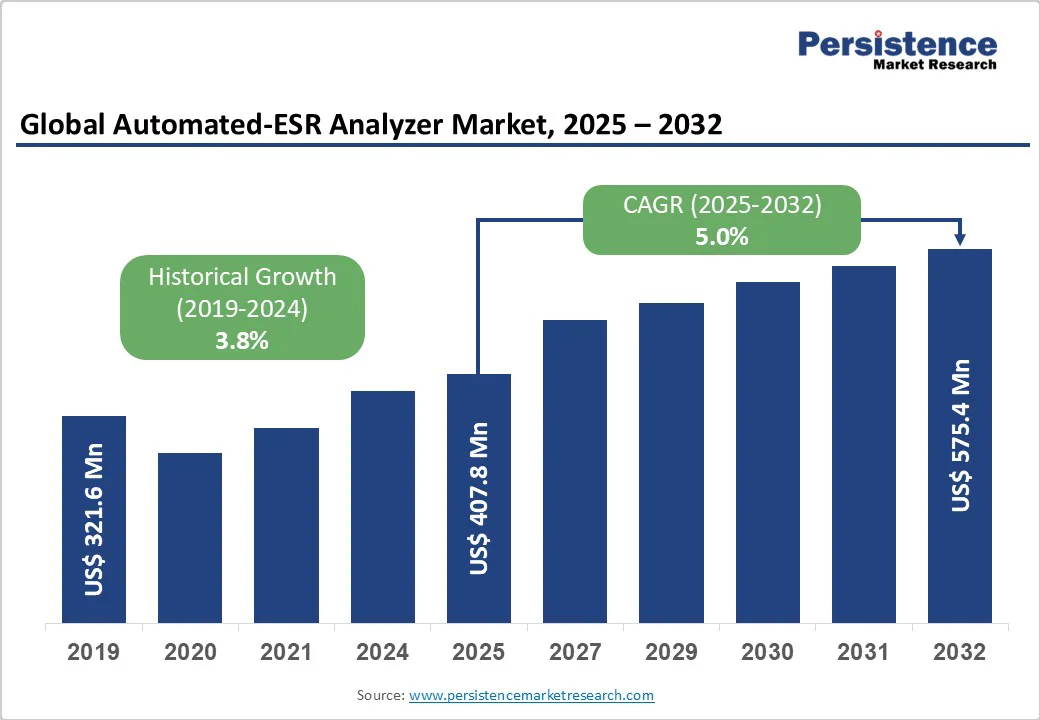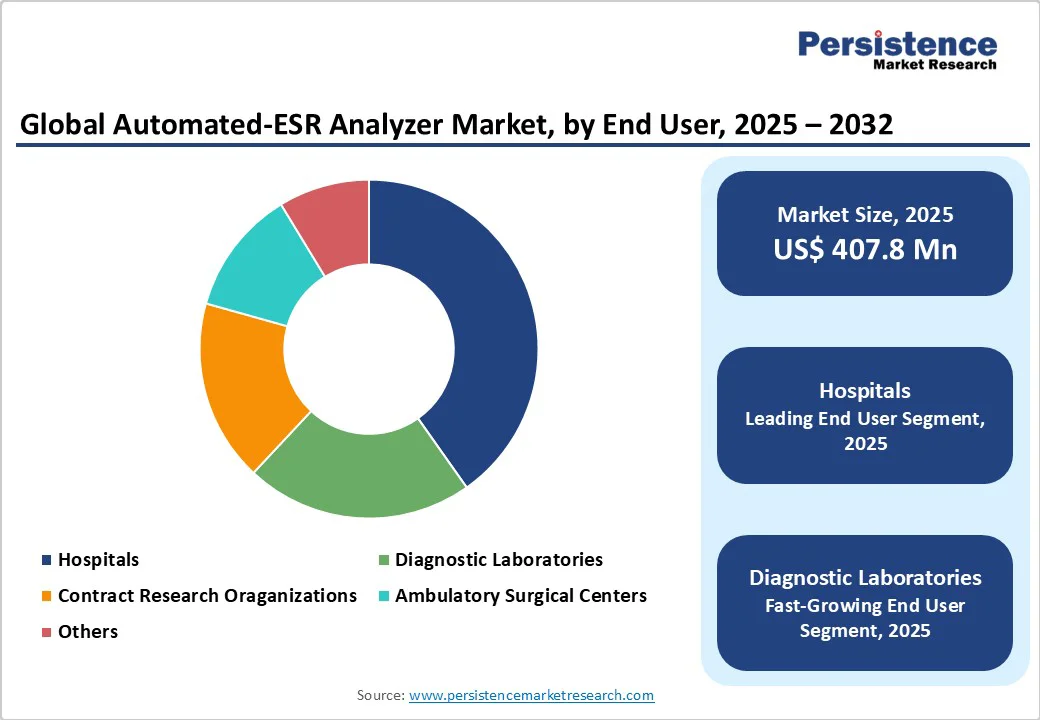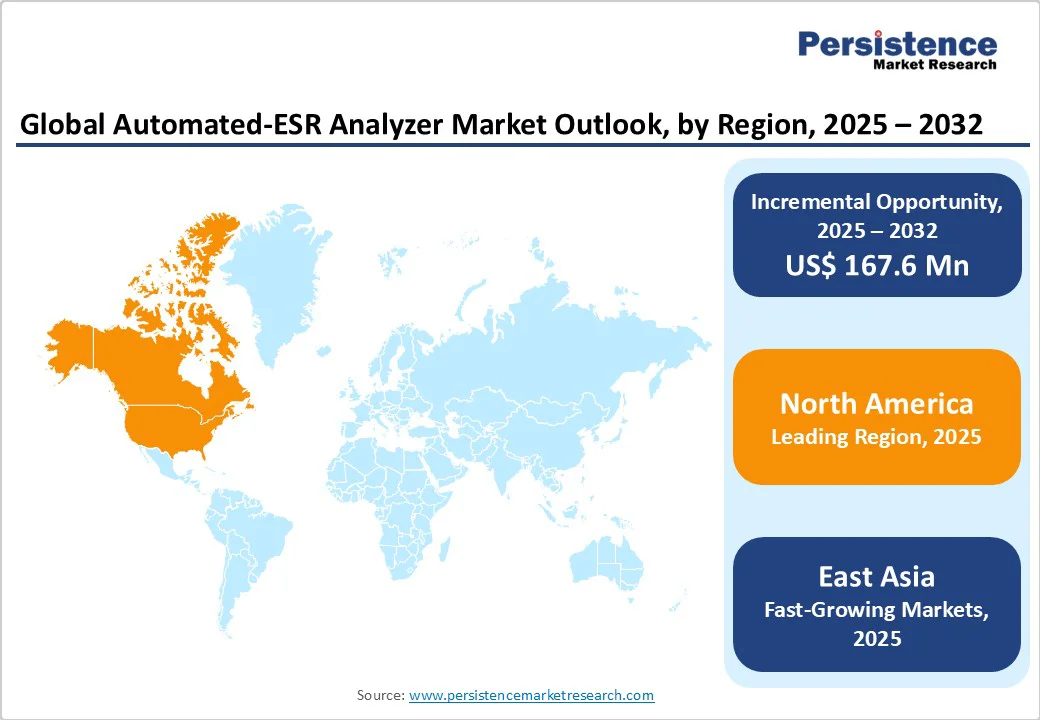ID: PMRREP22684| 197 Pages | 16 Oct 2025 | Format: PDF, Excel, PPT* | Healthcare

The global automated-ESR analyzer market is likely to be valued at US$407.8 million in 2025 and is projected to reach US$575.4 million by 2032, growing at a CAGR of 5.0% during the forecast period from 2025 to 2032.
The market is witnessing steady growth driven by increasing demand for faster, accurate, and standardized hematology testing. Automated ESR analyzers help measure erythrocyte sedimentation rate efficiently, reducing manual errors and improving workflow in clinical laboratories.
| Key Insights | Details |
|---|---|
| Automated-ESR Analyzer Market Size (2025E) | US$407.8 Mn |
| Market Value Forecast (2032F) | US$575.4 Mn |
| Projected Growth (CAGR 2025 to 2032) | 5.0% |
| Historical Market Growth (CAGR 2019 to 2024) | 3.8% |

The rising prevalence of inflammatory and autoimmune diseases is a significant driver for the Automated-ESR Analyzer Market. Diseases such as rheumatoid arthritis, lupus, multiple sclerosis, and chronic infections are increasing globally due to aging populations, environmental factors, and lifestyle changes.
Since the erythrocyte sedimentation rate (ESR) is a simple, cost-effective, and widely accepted screening marker for detecting inflammation, routine monitoring of patients has become essential. Hospitals, diagnostic labs, and clinics are increasingly relying on automated ESR analyzers to manage higher test volumes efficiently, reduce human error, and ensure rapid results.
Consequently, the growing patient pool with inflammatory and autoimmune disorders directly boosts demand for automated ESR testing, making it a critical segment in clinical diagnostics and laboratory automation.
Before being used in ordinary practice, automated erythrocyte sedimentation rate (ESR) analyzers must undergo comprehensive validation to demonstrate that they are comparable to the standard Westergren method. This is time-consuming and requires comparable evaluations for validity.
Additionally, there is a very significant danger of blood-borne infection for medical professionals who come into contact with blood samples. Due to unfavorable outcomes, many are turning to alternatives such as C-reactive protein, which offers a better signal of inflammation than ESR.
Early on in an inflammatory process, erroneous negative results are caused by the ESR's sluggish response to the acute phase reaction. Adverse medication responses are responsible for around 100,000 deaths annually in the United States.
Automated ESR analyzers are less appealing due to the unfavorable and detrimental effects of ESR caused by the use of certain medicines during therapy, such as oral contraceptives, vitamin A, aspirin, and cortisone, and this is anticipated to impede market expansion.
Emerging economies in the Asia Pacific region, including those in India, China, Thailand, Indonesia, and the Philippines, have a considerable market potential. A sizable patient base and an increase in the prevalence of infectious diseases present profitable growth prospects for businesses looking to record high revenues in the automated ESR analyzer market.
Therefore, increased investments by manufacturers and new players for the introduction of technologically advanced medical equipment is dramatically expanding their global footprint. For instance, the 2020 release of the Aerospray Cytology Slide Stainer Cytocentrifuge by ELITechGroup's Staining Technology, a device that accomplishes two tasks-sample preparation by cytocentrifugation and sample staining-has increased market potential.
There are many untreated patients in emerging economies. These regions provide manufacturers a sizable window of opportunity. According to estimates, sustainability will be aided by economic growth in these developing nations and patients' rising disposable income.
Additionally, it is predicted that an increase in the amount of money that various governments spend on healthcare will encourage diagnostic laboratories to use automated ESR analyzers. It is anticipated that this will increase demand for automated ESR analyzers.
Moreover, it is projected that favourable reimbursement policies, the introduction of automated ESR analysers, and growing healthcare infrastructure in emerging nations will catalyse market demand throughout the projection period.
Instruments held around 68% of the total market in 2025. When an instrument is fully automated from the moment a sample tube is inserted, it can be used walk-away. This is the case with fully automated ESR analyzers.
These instruments span a wide range of channels depending on the capacity needed, enabling use across numerous end-use scenarios. Modern fully automated analyzers require small sample quantities, making them ideal for testing pediatric samples.
Moreover, with semi-automated analyzers, sampling is carried out manually for equipment that use an external needle and uncapped tubes. These instruments have a few benefits, such as a reduced size that enables use in confined locations and fewer moving components that reduce the need for maintenance and/or repairs.
The portable automated ESR analyzer held around 72% of the total market in 2025. Portable ESR analyzers are portable devices that use the infrared sensor measurement concept and the Westergren analysis method. They can process up to 80 samples per hour while offering a measuring range of 1 to 140 mm/h.
The majority of devices feature a maximum simultaneous sample loading capacity of 40 and two measuring durations of 30 or 60 minutes. Reduced analysis time, as well as minimal special requirements, allow this segment to hold a dominant share within the global market.

The U.S. is set to account for around a 35% share in the global market in 2025. The adoption of modern technologies and the consolidation of medical facilities in this region are the primary drivers of market growth.
Several regulatory agencies and governments, particularly in developed economies, are implementing multiple cost-cutting strategies to lower their healthcare burden. Technological advances are clearing the way for the advancement of automated ESR analyzers beyond manual ESR analyzers, propelling the global market.
The increasing availability of automated ESR analyzers with advanced and novel technologies has boosted laboratory workflow while also improving turnaround time, which is another key reason driving global usage of automated ESR analyzers in the country.
The Asia Pacific Automated-ESR Analyzer Market is witnessing significant growth as the region emerges as a key hub for diagnostic innovations. Rising awareness about early detection of inflammatory and autoimmune diseases, coupled with increasing healthcare expenditure and expansion of modern diagnostic laboratories, is driving the adoption of automated ESR analyzers.
Countries like China, India, and Japan are seeing growing demand due to large patient populations and rising prevalence of chronic inflammatory conditions. Additionally, government initiatives to improve healthcare infrastructure, combined with increased accessibility to advanced laboratory technologies in tier-2 and tier-3 cities, are fueling market penetration.
The region’s focus on rapid, accurate, and cost-effective diagnostics positions Asia Pacific as a high-potential and fast-growing market for automated ESR analyzers.

Key competitors in the market for automated ESR analyzers are concentrating on developing new products that can be personalized for various purposes. Product manufacturers are using cutting-edge marketing techniques to increase their market share.
Increased investments in cutting-edge technologies to meet changing research needs; increased emphasis on technological innovation and advancement. Companies are heavily investing in R&D in order to increase their product portfolios and market presence globally, particularly to meet the changing needs of researchers.
The global market is projected to be valued at US$407.8 Mn in 2025.
Increasing cases of rheumatoid arthritis, lupus, and chronic infections are boosting demand for routine ESR testing.
The global market is poised to witness a CAGR of 5.0% between 2025 and 2032.
Combining ESR with CBC/DIFF, CRP, or other inflammatory markers offers comprehensive diagnostic solutions, attracting hospitals and laboratories.
Streck, Inc., Alifax Holding S.p.A., RR Mechatronics, HORIBA, and others
| Report Attribute | Details |
|---|---|
| Historical Data/Actuals | 2019 - 2024 |
| Forecast Period | 2025 - 2032 |
| Market Analysis | Value: US$ Mn, Volume if Applicable |
| Geographical Coverage |
|
| Segmental Coverage |
|
| Competitive Analysis |
|
| Report Highlights |
|
By Product Type
By Modality
By Analysis Time
By End User
By Region
Delivery Timelines
For more information on this report and its delivery timelines please get in touch with our sales team.
About Author